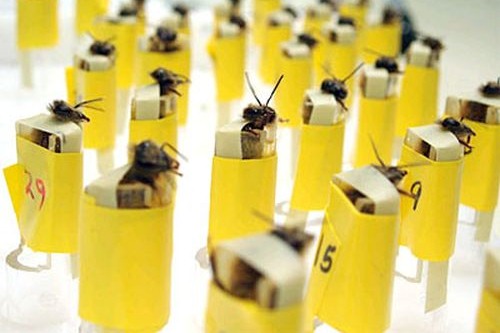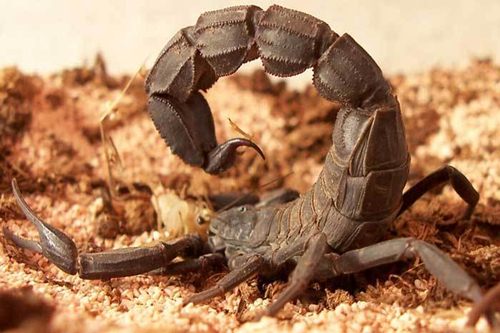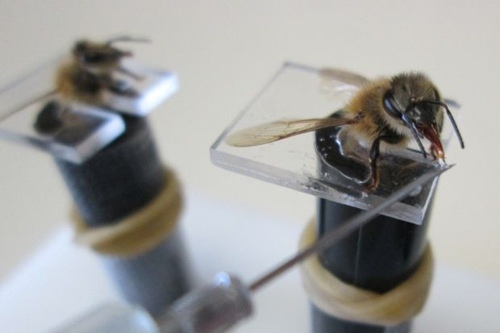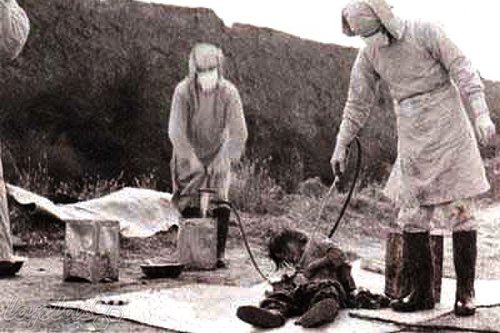10 Bizarre Attempts to Weaponize Insects
Bizarre attempts to weaponize insects: When it comes to war, man never hesitates to experiment with the strangest of ideas. As it turns out, we have even tried to use insects as weapons against our foes, and this was attempted as early as the ancient Roman era when the legions of Caesar would lob beehives from their catapults upon groups of enemy soldiers. The scientific term for it is “entomological warfare” and it involves the use of insects to either spread a deadly pathogen, such as the cholera or plague virus, or it uses crop eating insects to cripple the enemy’s food supplies. This list takes a look at some of the most bizarre attempts to weaponize insects.
10. “Bee Bombs” Used By Ancient Roman Legions
Anyone who has been bitten by a bee is fully aware of what these little devils are capable of when provoked. In their bizarre attempts to weaponize insects, the Roman legions would often use this to their advantage, by using catapults to hurl beehives over the walls of enemy fortresses. Terrified and unable to fight back, the enemy forces would become easy targets for Roman artillery and archers. Romans even used bees on their ships, they would throw specially designed clay jars, filled with bees on the decks of their enemies, forcing some desperate sailors to jump into the sea.
However, the Romans got a taste of their own medicine when they tried to siege the Greek town of Themiscyra. The Greek soldiers who were outnumbered and under danger of being pushed into a corner, threw hundreds of beehives upon the Romans trying to take over the town. Also, there are historical records of poisonous honey being used to defend certain villages of Turkey from both Greek and Roman invasions. In one case, while Greek soldiers were looting villages near Trapezus, Turkey, they found some hives filled with honey.
After they joyfully consumed the honey, they started to lose their senses and began vomiting. They could not fight and were killed in the thousands. A similar case happened sometime later when the Roman soldiers under the leadership of the great Pompeii tried to invade the Trebizond region of Turkey. The locals were aware that honey produced during certain times of the year was naturally poisonous and cleverly laid down hives filled with honey along the village streets. Unsuspecting Roman soldiers ate the honey and fell ill, becoming easy targets for the Heptakometes warriors.
9. Scorpion Bombs Used To Defend The Fortress Of Hatra
Believe it or not, the most bizarre attempts to weaponize insects dates way back than you think. Two thousand years ago, when the Roman emperor Septimus Severus had set his sights on conquering Mesopotamia, he bought with him an army of several thousand soldiers. The desert fortress of Hatra stood in his way, a giant fort with a five-mile defensive perimeter and, a moat sandwiched between 40-foot high walls. Holed up inside were King Barsamia and his citizens, who were not prepared to go down without giving the Romans a battle of a lifetime. And they did, hurling down hundreds of state-of-the-art “scorpion grenades” from the top of the fort walls. These were actually earthenware vessels loaded with deadly desert scorpions.
Any wildlife expert will tell you that desert scorpions such as the Iraqi Deathstalker are not to be toyed with. The sting of a venomous scorpion can cause extreme pain, even death. It did not take long for the Romans to succumb to the terror of thousands of these deadly insects raining upon them, and they eventually abandoned their siege.
8. Sniffer Bees That Sniff Out Landmines
While it may sound like one of the dumbest attempts to weaponize insects, but considering we already have dogs and electronic devices to carry out the deed, biologists in Croatia, who developed and trained a new strain of sniffing bees claim these insects can detect landmines and IED’s faster than sniffer dogs, and from as far as 3 miles away. Apparently these bees were trained in an effort to purge Croatia of hidden landmines, which were planted during the Croatian War of Independence and are estimated to cover more than 684 square miles of Croatian territory.
Biologists and beekeepers worked together over a period of 3 years to develop the special bees, they train the bees to search for the smell of explosives by mixing that smell in a sugary solution they feed to the bees. Over time the bees acquire a sense of smell that is tuned to sniffing outlandmines and similar explosive devices.
7. Sniffer Bees That Detects Illegal Drugs
We have probably realized by now that bees are awesome, since they can produce honey, attack our enemies, and even sniff out bombs. But their race to become the most amazing bug doesn’t end there. Since bees have a sharp olfactory sense, which is comparable to sniffer dogs, they are also the perfect candidate when it comes to replacing the dogs as portable drug detectors. With marijuana getting legalized in places all over the world, the dogs that were trained to detect marijuana will now be hard to retrain in order to find other substances such as heroin or cocaine.
Also training of new sniffer dogs requires a lot of time. But research has proved that bees are the perfect substitute to dogs as they too respond to the same kind of conditional training that dogs are given. In the bizarre attempts to weaponize insects, bees in various experiments were able to differentiate between heroin and cocaine which means they can one day prove as a safer and more portable alternative to dogs. This will be a great help to police and airport security all over the world, as it is both an inexpensive and low maintenance alternative to canines.
6. DARPA’s Cyber Bug Project

DARPA (Defense Advanced Research Project Association) is the top secret research wing of the US Army, and is known to be working on a variety of projects in neurological science, robotics, futuristic guns, and other cool stuff including having made bizarre attempts to weaponize insects. But one of their projects is rather unique-it involves hacking into the body of an insect to allow a human operator to control the bugs actions through a controller. The bugs are controlled by inserting metal electrodes into certain parts of the body, like the brain and specific muscles that are responsible for flapping the wings and moving limbs. Then these electrodes are connected to a bug-backpack, which is basically a custom built circuit board with a microchip and radio transmitter/receiver on it, along with a tiny power supply.
The cyborg bugs can be used in various missions, for reconnaissance in insurgent territory,detecting explosives and drugs (remember sniffer bees?), even search and rescue. With a camera and microphone mounted on each bug, operators will be able to determine the number and positions of terrorists hiding in a building without sending a single soldier inside. In the event of an earthquake the bugs could scout the city for survivors. And, they can be used to “bug” conversations.
5. Operation Big Itch
This may sound like the brainchild of some comic book supervillain, but is actually a field test conducted in September, 1954 by the US government to determine the feasibility of fleas as a vector(carrier) for pathogens. The idea behind it involves taking a large number of fleas infected with some deadly virus, like the hepatitis or cholera virus, and then releasing them in a densely populated city to kill hundreds of thousands of people. The test conducted by the US government obviously involved uninfected fleas.
The US government, which had recently uncovered tons of documents and years of data regarding entomological warfare in the Nazi’s labs, in their bizarre attempts to weaponize insects, was seriously thinking about the prospects of using bugs as a biological weapon of mass destruction.Fleas and mosquitoes are well known to be capable vectors of a large number of disease causing pathogens. The plan was to test the coverage pattern of the fleas by dropping thousands of them inside bombs from an airplane, over a testing ground in Utah. Guinea pigs, used as test subjects had been placed in a 660 yard grid. During preliminary tests, some of the bombs failed, which resulted in the fleas biting the aircraft crew and pilots. The trials were successful and the operation proved that the fleas could not only survive the drop, but could also attach themselves to hosts soon after.
4. Operation Big Buzz
Another crazy experiment by the US Government, this time the targeted hosts were the residents of Georgia, and the vectors were 333,000 yellow fever mosquitoes. Again, the mosquitoes were not infected, the purpose of this mission just like the previous one was to test the feasibility of dropping thousands of mosquitoes over a crowded city and estimate the coverage area of the mosquitoes. Carried out in May, 1955, this test dropped 330,000 uninfected yellow fever mosquitoes over the state of Georgia. Reports exist of the US military planning to develop an entomological warfare facility capable of producing 100 million mosquitoes infected with yellow fever, every month. Operation Big Buzz is among the most bizarre attempts to weaponize insects in the history of mankind.
3. Operation Drop Kick
In a series of tests carried out between April and November of 1956, similar to the previous operations like Big Buzz, the US Army carried out a test to determine the spread patterns, bite intensity and cost per death (the amount of money required to kill one man with mosquitoes) of yellow fever mosquitoes. The tests were carried out in two separate stages-the first stage released mosquitoes in a residential area in Savannah, Georgia by dropping them from airplanes in parachute assisted paper bags designed to open upon touching the ground. The second stage released over 600,000 yellow fever mosquitoes over the Avon air base area. After dropping the mosquitoes, Army officials posing as public healthcare agents roamed from door to door investigating the effects of the mosquito drops. Although the government maintained that the mosquitoes were not infected with any disease, as many as 7 deaths from yellow fever and dengue were reported in the area. This could be the result of introducing so many disease carrying mosquitoes at once in an area. Its among most bizarre attempts to weaponize insects.
2. Hitler Planned To Drop Malaria Bombs On America
It really isn’t surprising that Hitler would feature in a list if to bizarre attempts to weaponize insects. Towards the end of World War 2, after the Allied forces captured Germany, some very disturbing information regarding Nazi secret experiments was revealed. Nazi scientists at the Dachau concentration camp, under SS head Heinrich Himmler were carrying out experiments to breed a new “master race” of mosquitoes that would be able to survive a flight over the Atlantic ocean, all the way to America. The big plan was to infect millions of mosquitoes with malaria and then drop mosquitoes from the air on American civilians, which would have resulted in the death of Americans by the millions. An attack like this was practically unrealistic, owing to the short lifespan of mosquitoes and their sensitivity to high altitude and varying temperatures. Other than that, the Fuhrer himself had ordered that no German was to experiment with biological warfare, as spreading diseases was the work of the Jews according to Hitler.
However in January, 1942, the leader of the SS, Heinrich Himmler had ordered the development of an entomological warfare research facility to study the physiology of disease carrying vectors such as mosquitoes and fleas. It operated within the infamous Dachau concentration camp where Jewish prisoners were held and tortured by carrying out horrifying experiments on them. The prisoners were often used as test subjects to find out the killing potential of infected mosquitoes. Initially the institute was ordered to research how to protect the German people from diseases such as cholera and malaria in case such an epidemic broke out. But towards 1944, when Germany was getting surrounded by both Russian and American troops, the institute desperately changed its objectives from protection to assault.
The documents reveal that had the research gone any further, the Allied forces might have been faced with a serious threat. All that Nazi research would soon be collected by American biologists, who used it to boost the US biological warfare program, eventually resulting in tests like Big Buzz and Drop Kick.
1. The Japanese Unit 731
When it comes to experiments, the Japanese Unit 731 always gets mentioned. So it isn’t surprising that it ranks number one in our list of bizarre attempts to weaponize insects. Usually when we think about war crimes of the World War 2 era, Nazis and the Holocaust come to mind. They killed thousands in concentration camps, gassed millions of Jews and war prisoners, and carried out unspeakable horrors in the form of human experimentation. But what few people realize is that Japan too has committed a lot of ghastly atrocities in the form of live human dissection, experimentation on babies, artificial insemination and massacres. When the Japanese Army invaded mainland China, they set up a top secret facility in Pingfan, Manchuria. This facility was the home of the infamous Unit 731, the Japanese equivalent of the Nazi SS biological warfaredivision. It was a 6-square km facility which was protected by high walls, armed personnel and electric barbed wires.
In this facility, the Japanese carried out research on infecting people with cholera, typhoid, plague and other ghastly diseases, their favorite medium to do so was the flea. The Japanese biologists estimated that a single flea can release 20000 to 24000 plague viruses in a single bite, and can stay active as long as one month. The facility experimented on Chinese prisoners, most of whom were supposedly prisoners and bandits. They also killed Russian, American and British POW’s. Women and children were killed in the thousands.
It is known that the facility could produce enough plague and cholera viruses to kill all humans in the world many times over, specifically 300 kg of bacteria and viruses a day. The Japanese were even planning to release plague infected fleas on America from balloons. Over 3000 people were killed in the facility according the reports of captured Japanese scientists, but it is clear much more were killed. In fact, the prisoners used as guinea pigs for biological warfare testing were referred to as “Maruta” or wooden logs, and were disposed in giant furnaces after they were killed. The facility was known to store infected rats, fleas and mosquitoes in the thousands.
Just before the Allied forces captured the area, Japanese destroyed the facility to erase all traces of evidence and any research data. The rats, fleas and mosquitoes that escaped killed numerous people. It is estimated that around 300,000 people, mostly Chinese were killed by spreading plague infected fleas, and rats.
10 Bizarre Attempts to Weaponize Insects
- The Japanese Unit 731
- Hitler Planned To Drop Malaria Bombs On America
- Operation Drop Kick
- Operation Big Buzz
- Operation Big Itch
- DARPA’s Cyber Bug Project
- Sniffer Bees That Detects Illegal Drugs
- Sniffer Bees That Sniff Out Landmines
- Scorpion Bombs Used To Defend The Fortress Of Hatra
- “Bee Bombs” Used By Ancient Roman Legions
Written by: Saurav Rath












No comments